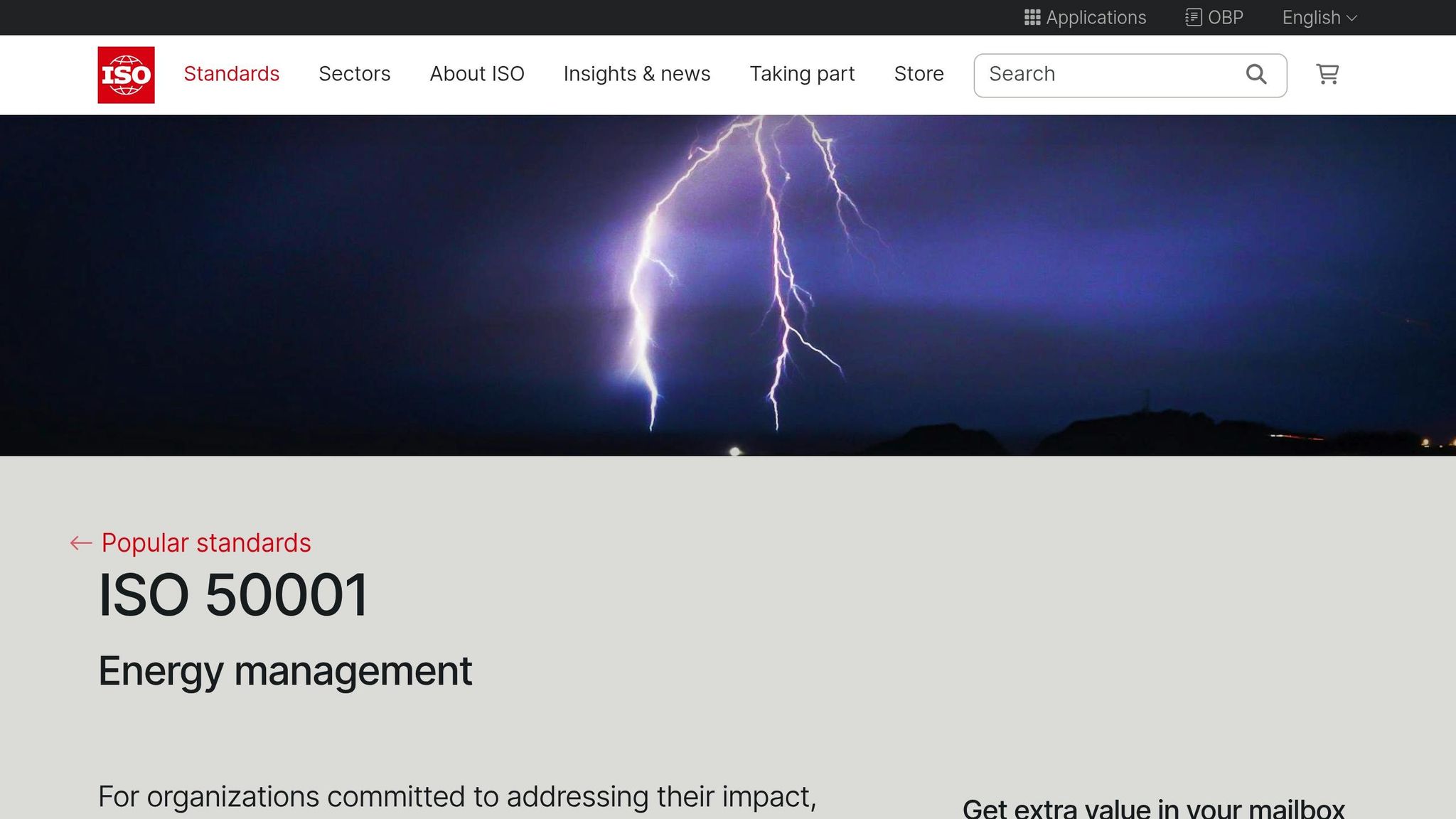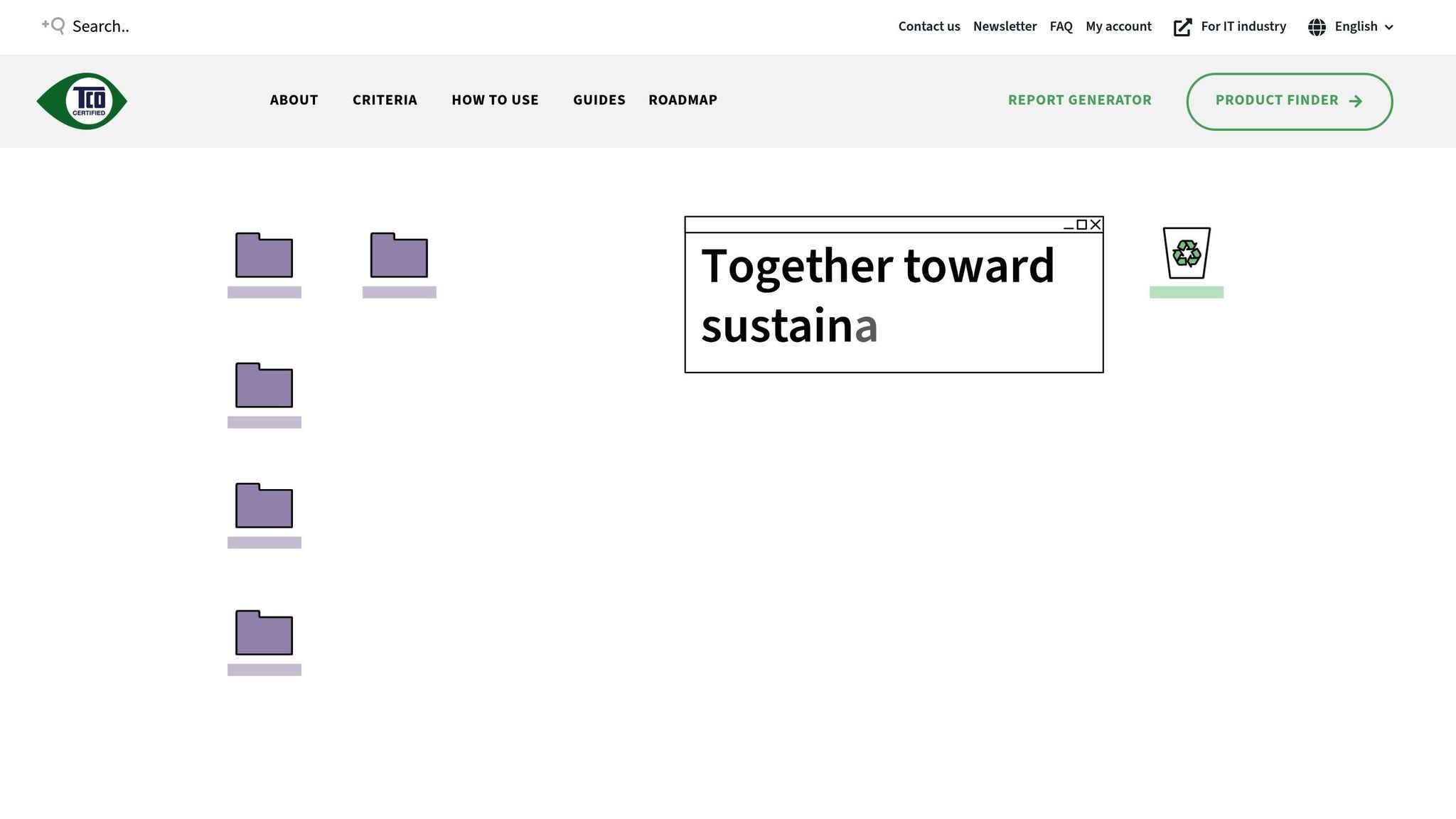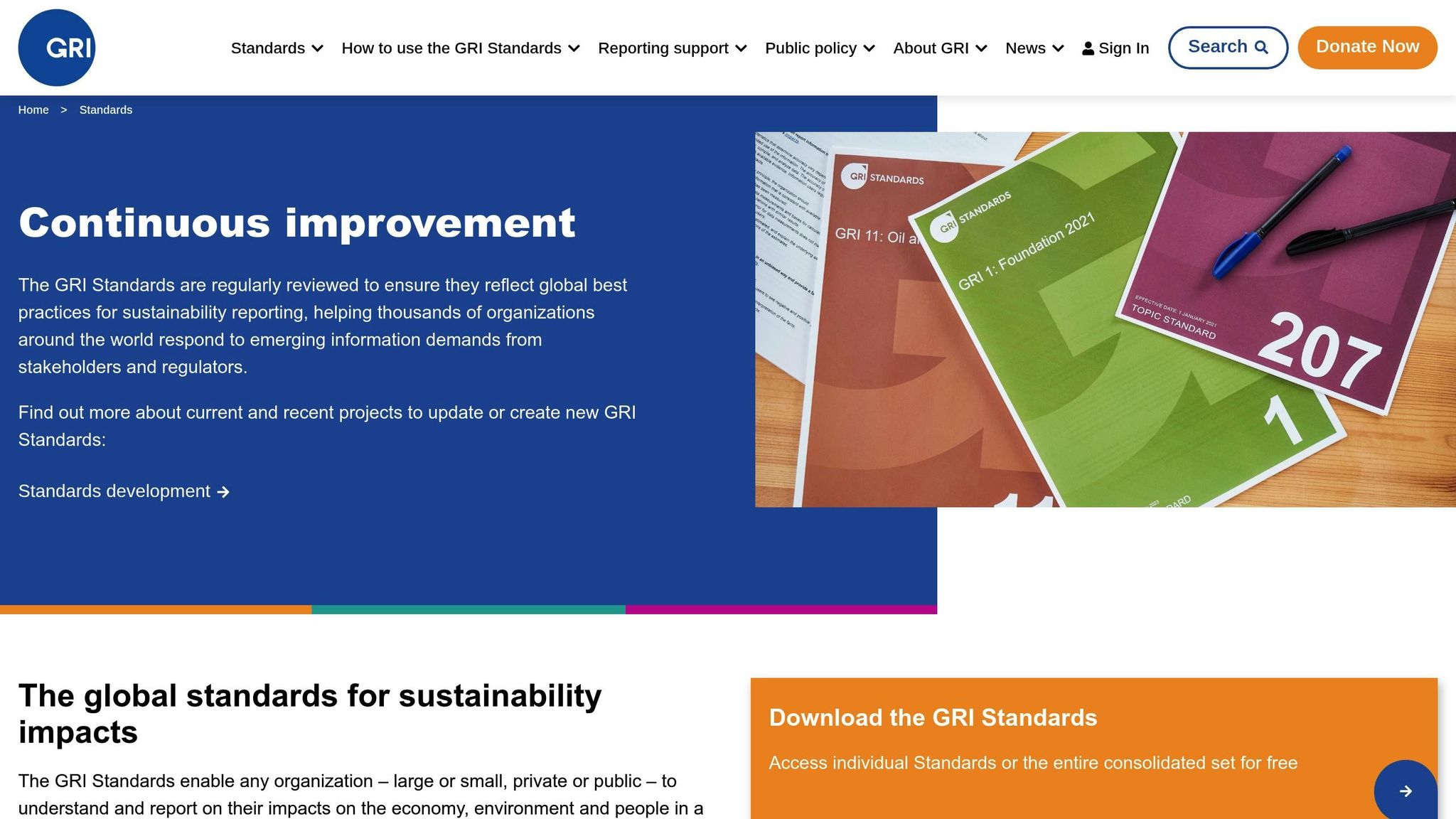Digital sustainability is about using technology responsibly to reduce environmental impact while ensuring long-term usability. Businesses can adopt frameworks like ISO 50001 for energy management, TCO Certified for sustainable IT products, and GRI Standards for transparent reporting to achieve this. These standards not only help reduce emissions but also improve efficiency, meet regulations, and enhance market trust.
Key Takeaways:
- Digital Impact: The internet contributes ~3.7% of global emissions, and IT accounts for 2.1-3.9%.
- Why It Matters: 80% of consumers prefer sustainable brands, and companies with strong environmental practices see higher revenues.
- Certifications:
- ISO 50001: Focuses on energy efficiency in IT systems.
- TCO Certified: Ensures IT products meet lifecycle and emissions standards.
- GRI Standards: Guides sustainability reporting for transparency.
- Benefits: Certifications build credibility, reduce costs, and open new business opportunities.
To get certified, start by reviewing your current practices, choose the right standards, and prepare for audits. These steps ensure compliance, improve operations, and position your business for future success in a competitive market.
Webinar - Sustainability reporting series: Key frameworks
Key Digital Sustainability Standards
With the carbon footprint of digital technology expected to triple by 2050, businesses need clear guidelines to manage their environmental responsibilities. Three key standards have become essential for addressing digital sustainability: ISO 50001 for energy management, TCO Certified for sustainable IT products, and GRI Standards for transparent sustainability reporting. Together, these frameworks tackle energy efficiency, product lifecycle impacts, and accountability in digital operations.
ISO 50001: Managing Energy in IT Infrastructure

ISO 50001 is designed to improve energy performance, cut energy usage, and reduce carbon emissions. It helps organizations create energy management systems by setting policies, establishing measurable targets, making decisions based on data, and fostering continuous improvement. This standard also aligns with ISO 14001 and ISO 9001, making it adaptable for broader organizational goals.
For IT infrastructure, ISO 50001 is especially effective. It enables businesses to monitor and enhance energy efficiency across data centers, networks, and computing systems. This focus is critical, as data centers and networks contribute up to 22% of the digital sector's carbon footprint in France alone.
"The ISO 50001 standard for energy management systems can help safeguard our future by making a positive difference in the here and now." – ISO
Next, let’s look at a standard that takes a full lifecycle approach to IT product sustainability.
TCO Certified: Prioritizing Sustainability in IT Products

TCO Certified addresses the environmental and social impact of IT products throughout their lifecycle. It sets rigorous criteria for climate impact, material safety, circularity, and supply chain practices. Each year, over 10,000 hours are spent refining these criteria, and more than 20,000 hours are devoted to audits and testing to ensure compliance.
A major focus of TCO Certified is reducing scope 3 emissions, which account for roughly 80% of total emissions from IT products. Certified products must meet specific requirements, such as using renewable energy, extending product lifespans, improving energy efficiency, and adopting safer materials. By 2025, brands with certified products will also need to purchase renewable electricity equivalent to 15% of their assembly factories' consumption and implement ISO 14001 and ISO 50001 management systems.
With over 60 million tonnes of e-waste generated globally each year, TCO Certified’s emphasis on product longevity, circular practices, and responsible disposal is increasingly important.
While TCO Certified focuses on product lifecycle impacts, GRI Standards emphasize transparency in sustainability reporting.
GRI Standards: Reporting on Sustainability in Digital Operations

GRI Standards offer a framework for clear and consistent reporting on sustainability impacts across economic, environmental, and social dimensions. As a global standard for ESG reporting, it helps organizations communicate their sustainability efforts effectively. The framework also encourages companies to set measurable goals and track their progress over time.
For digital operations, GRI Standards provide tools for reporting on critical metrics like energy use, carbon emissions, waste management, and resource efficiency. They also cover social factors, including employee well-being, diversity, and community engagement. The GRI Professional Certification Program further supports organizations by building expertise in implementing these standards, ensuring high-quality and reliable reporting.
ISO 50001, TCO Certified, and GRI Standards collectively offer a robust approach to digital sustainability. Together, they provide businesses with the tools to improve operations, design more sustainable products, and communicate their environmental efforts transparently.
Digital Sustainability Certification Programs
Earning a certification in digital sustainability involves understanding the available programs and their specific requirements. For businesses looking to validate their sustainable practices, three major programs stand out: TCO Certified for IT Products, GRI Professional Certification for sustainability reporting, and ISO certification processes for management systems. These programs build on the standards discussed earlier, offering practical ways to demonstrate environmental accountability through verifiable methods.
TCO Certified for IT Devices
TCO Certified applies to 3,500 products across 12 electronic product categories. The certification focuses on four key areas: climate impact, hazardous substances, circularity, and supply chain responsibility. Compliance is verified independently, ensuring credibility.
To achieve TCO certification, businesses must first review the criteria, work with a TCO-approved verifier, and submit product samples for testing along with the required documentation. Certified organizations are also required to provide annual reports on energy sources, promoting ongoing improvements in sustainability. In January 2025, TCO Certified introduced updated criteria, including mandatory renewable electricity use in final assembly factories and extending product lifespans beyond five years, with free security software updates.
A practical example of TCO Certified's impact comes from AB Group, an IT distributor in central and eastern Europe. They integrated data from TCO Development’s Product Finder into their business-to-business platform, offering sustainability information for nearly 1,000 certified product configurations. Patrycja Gawarecka, Sales Director at AB S.A., highlights the benefits:
"Products certified according to TCO Certified can have long product life thanks to their high durability and repairability. A great way to minimize a product's negative environmental and social impact is by choosing a product that can be used for longer."
The next program, GRI Professional Certification, focuses on building expertise in sustainability reporting.
GRI Professional Certification
The GRI Professional Certification Program helps individuals develop skills in sustainability reporting through a structured curriculum. Participants can choose between self-paced online courses or instructor-led training, culminating in the title "GRI Certified Sustainability Professional" upon passing the final exam. This certification demonstrates an individual's ability to effectively use GRI Standards to create high-quality sustainability reports, improving ESG communication and stakeholder engagement. As GRI explains:
"GRI plays a vital role in shaping a more sustainable and resilient future by fostering a transparent dialogue between organizations and their stakeholders, driving positive change on a global scale."
ISO Certification Process
ISO certifications focus on creating and improving management systems within organizations rather than certifying individual products or personal expertise. Two key standards are ISO 50001 for energy management and ISO 14001 for environmental management systems.
To obtain ISO certification, organizations must develop and implement a management system, conduct internal audits, and undergo a two-stage external audit. Accredited certification bodies first review documentation and then assess the on-site implementation of the system. If successful, the organization receives ISO certification, valid for three years, with annual surveillance audits to ensure continued compliance.
These certification programs offer businesses the tools to validate their digital sustainability efforts. Whether the focus is on product certification, individual expertise, or organizational management, each program provides a pathway to demonstrate commitment to sustainable practices in the digital industry. The choice depends on the specific needs and goals of the business.
sbb-itb-01010c0
How to Get Digital Sustainability Certification
Earning a digital sustainability certification involves a structured process that begins with evaluating your current practices and ends with passing audits successfully. This journey typically includes three main steps: assessing your existing operations, selecting the right standards, and preparing for certification requirements.
Review Current Infrastructure and Practices
Before diving into certification, it’s important to perform a gap analysis to see how your current operations measure up against established sustainability standards. This step helps pinpoint areas that need improvement.
Start by assessing your digital operations based on critical sustainability metrics like energy efficiency, waste management, water conservation, carbon footprint, and governance practices.
The industry data reveals some stark gaps. For instance, only 41% of digital infrastructure operators report water usage, while just 26% track IT waste or recycling. Even fewer - 23% - report all three Scopes (1, 2, and 3) of carbon emissions. These numbers highlight areas where many businesses fall short.
Your evaluation should focus on several key areas, such as the performance of IT equipment, energy and water usage, carbon emissions, and waste management. Pay special attention to the reuse and recycling of outdated equipment. Gather detailed data on energy consumption, device lifecycles, and data storage to uncover opportunities for improvement.
Once you’ve identified gaps, establish clear policies for sustainable practices, including procurement, energy efficiency, and e-waste management. These policies will serve as a foundation for your certification efforts.
With a clear picture of your current standing, you can move on to selecting the standards that fit your goals.
Choose and Apply Relevant Standards
The right certification depends on aligning your sustainability objectives with the appropriate standards. These certifications not only help you reach your goals but also enhance your credibility and market appeal.
Start by defining your corporate social responsibility goals and sustainability priorities. Assess how different certifications align with these objectives. Collect data about your operations and supply chain to ensure you’re well-prepared for the certification process.
Think about which claims - whether about your products or your company as a whole - would benefit most from third-party verification. Choose a standard that is both reputable and rigorous, and make sure you allocate the necessary resources and budget for the process. Certifications can be more than just a stamp of approval - they’re an opportunity to evaluate and improve your overall practices. Involve key stakeholders and gain long-term commitment from senior leadership to ensure the process runs smoothly.
Once you’ve selected the right certifications, it’s time to update your processes and get ready for the audit.
Prepare for Audits and Certification Exams
Getting ready for a sustainability certification audit involves understanding the standards, gathering the necessary documentation, and engaging with your team and stakeholders. This preparation is crucial for meeting the requirements and achieving certification.
Start with a detailed analysis to identify where your practices fall short of the standards. Use this information to address specific gaps before the audit.
Set up a reliable system for collecting data across all relevant areas. Adjust your reporting framework to match the metrics and indicators required by your chosen certification. This ensures your data aligns with global standards and reinforces your commitment to sustainability.
Train your team on the certification requirements and the importance of accurate reporting. Make sure they understand not just what data to collect but also why accuracy and completeness are vital.
Conduct an internal review to catch any inconsistencies and ensure your documentation fully supports your sustainability claims. Auditors will expect thorough records that back up your claims and show ongoing compliance.
Keep communication open with stakeholders, including employees, investors, and customers, throughout the process. Transparency fosters trust and provides valuable feedback.
Benefits of Digital Sustainability Certification
Achieving digital sustainability certification isn’t just about meeting a set of standards - it’s about unlocking real, measurable advantages for your business. These certifications validate your efforts and deliver clear benefits, from improving your environmental impact to enhancing your market position, all while helping you thrive in the competitive U.S. market.
Building Credibility and Earning Market Trust
Digital sustainability certifications provide third-party validation of your environmental claims, helping you earn trust from customers, investors, and partners. Instead of relying on marketing promises, these certifications serve as proof of your commitment to sustainability.
The demand for sustainable practices is surging. Studies reveal that 46–80% of consumers are willing to pay an average premium of 9.7% for products made sustainably. Certifications like B Corp, Green Seal, and Cradle to Cradle Certified™ help businesses stand out by demonstrating their environmental responsibility. This not only appeals to eco-conscious consumers but also reassures investors and partners by providing transparency during due diligence. By aligning with recognized standards, businesses can validate their environmental and social performance, reinforcing their competitive edge in the digital marketplace.
Improving Efficiency and Lowering Environmental Impact
Adopting digital sustainability standards can lead to significant operational improvements. Research shows that 83% of studies on sustainability standards highlight operational benefits, with 60% of them linking these standards to better efficiency and risk management. These improvements translate into cost savings and even fewer workplace accidents.
For example, focusing on digital resource efficiency - like reducing energy consumption, optimizing data storage, and extending hardware lifespans - can have a major impact. Hosting on renewable energy-powered servers can cut emissions by up to 80%, while using efficient image formats like WebP can reduce image sizes by the same amount. Optimizing website images and code alone can lower emissions per page view by 26%, saving over 1.74 metric tons of CO₂ annually across 15 websites. Additionally, strategies like cloud optimization, better algorithm design, and smarter hardware management contribute to long-term cost reductions while minimizing environmental impact.
Unlocking New Opportunities and Aligning with ESG Goals
Certifications aligned with environmental, social, and governance (ESG) criteria can open doors to fresh funding opportunities and partnerships. Companies with verified ESG credentials are more likely to attract ESG-focused investors, creating pathways to new financial resources. According to the European Banking Authority, businesses that prioritize environmental governance and risk management often see significant returns from proper ESG certification.
These certifications do more than just attract investors - they sharpen your competitive edge, improve communication with stakeholders, and streamline supplier management. They also demonstrate a long-term commitment to sustainability, which can enhance profits, boost brand recognition, and attract top-tier talent and loyal customers. Furthermore, certifications help businesses stay ahead of regulatory changes, reducing the risk of costly last-minute adjustments. By promoting better environmental practices and governance, they also strengthen risk management strategies.
“ESG identifies societal factors that impact business success and converts them into opportunities and risks.” – Insead Knowledge
The real value of ESG certifications lies in selecting ones that align closely with your business goals. This ensures that your efforts are meaningful and directly tied to your industry’s objectives, rather than being generic sustainability claims.
“We argue that ESG strategies should be valued for the unique benefits that they can provide, such as making a positive impact on the environment or society, as opposed to being promoted on the basis of disputable claims regarding their outperformance potential.” – EDHEC Climate Institute
These advantages highlight how digital sustainability certifications can serve as a foundation for navigating the evolving demands of sustainability in the digital age.
The Future of Digital Sustainability
Digital sustainability has become a critical focus for businesses. Looking ahead, stricter regulations, evolving investor expectations, and growing consumer demands are reshaping the landscape. Companies that adapt to these shifts will position themselves to succeed in an increasingly competitive marketplace. These changes signal the need for deeper, more strategic approaches to sustainability.
With 80% of companies planning to increase sustainability investments and 77% of B2B decision-makers prioritizing environmental impact, the push for sustainable practices is no longer optional - it’s a competitive edge.
Key Considerations for B2B Professionals
For B2B professionals, these trends highlight the importance of refining sustainability strategies. A key focus is on accurate measurement and transparent reporting. For instance, Scope 3 emissions, which account for nearly 90% of a company’s total emissions, can no longer be overlooked. Additionally, a European Commission study revealed that 53.3% of environmental claims from EU organizations were vague or misleading, emphasizing the need for third-party certifications and reliable data collection.
To address these challenges, organizations are adopting robust data systems and frameworks like the GHG Protocol to set science-based targets. They’re also preparing for regulations such as the CSRD and implementing Digital Product Passports to ensure lifecycle transparency. Beyond compliance, businesses are embracing circular practices by extending hardware lifespans, optimizing cloud usage, and collaborating with suppliers who prioritize sustainability.
As certification programs grow, there’s increasing demand for experts skilled in navigating this complex terrain. Whether through ISO certifications, GRI credentials, or specialized training in digital sustainability, investing in expertise not only enhances career opportunities but also strengthens organizational capabilities.
How the B2B Ecosystem Supports Sustainability
The B2B Ecosystem plays a pivotal role in connecting technology with sustainable practices. By aligning with established certifications, it helps businesses achieve long-term value, transparency, and equity. Through a suite of tools and consulting services, the ecosystem enables companies to integrate sustainability into their digital strategies.
- AI Process Optimizer: Identifies inefficiencies in digital operations to enhance sustainability.
- TAM Analyst and Market Entry Navigator: Assists businesses in evaluating sustainability opportunities in emerging markets.
- Consulting Services: Provides hands-on support for certification processes, from initial assessments to implementation and monitoring.
- Partner Directory: Links organizations with verified sustainability partners to strengthen supply chains.
As expectations for ESG disclosures and commitments grow, the B2B Ecosystem’s resources help businesses stay ahead of regulatory demands while fostering transparency and trust. The future belongs to companies that see digital sustainability not just as a compliance measure but as a driver of innovation, operational efficiency, and growth - strategies that benefit both the bottom line and the broader digital economy.
FAQs
What steps should a business take to adopt digital sustainability standards?
To embrace digital sustainability standards, businesses should begin by ensuring strong leadership support. This commitment lays the foundation for allocating the necessary resources and gaining organizational backing. It's also important to involve key stakeholders - employees, customers, and suppliers - to develop a balanced and collaborative strategy.
The next step is conducting a baseline assessment. This helps evaluate current performance and highlights areas that need improvement. From there, set specific, measurable goals that align with your business objectives while keeping an eye on long-term outcomes. Lastly, establish a system to track progress, collect feedback, and make ongoing adjustments. This approach ensures steady improvement and long-lasting results.
How can certifications like ISO 50001, TCO Certified, and GRI Standards boost a company's credibility and market standing?
Certifications like ISO 50001, TCO Certified, and GRI Standards can significantly boost a company's reputation and competitive edge. Take ISO 50001, for instance - it focuses on enhancing energy efficiency. By adopting this standard, businesses can cut energy costs while signaling their dedication to sustainability, a value that resonates deeply with eco-conscious consumers and investors.
On the other hand, TCO Certified targets IT products, ensuring they meet rigorous environmental and social criteria. This certification not only strengthens trust but also bolsters a brand's image by showcasing its commitment to responsible practices. Similarly, GRI Standards support transparent reporting on sustainability efforts, helping businesses demonstrate accountability and earn stakeholder confidence.
By integrating these certifications, companies can streamline operations, build trust with their audience, and foster stronger relationships with investors and partners - paving the way for sustained growth and loyalty.
What challenges do businesses face when achieving digital sustainability certifications, and how can they address them?
Achieving digital sustainability certifications often presents a tough hurdle for businesses, primarily because of high costs. These expenses can include audit fees, training programs, and implementation efforts, which can be particularly burdensome for smaller companies. On top of that, the complexity of standards and a lack of in-house expertise can make the path to compliance feel overwhelming. Another common challenge is evaluating the return on investment (ROI) - the benefits, like enhanced reputation or increased employee engagement, tend to be long-term and harder to quantify.
To tackle these obstacles, businesses can focus on training programs to develop internal expertise and foster a workplace culture centered on sustainability. Collaborating with consultants or industry experts can also simplify the certification process. Additionally, clearly outlining the long-term advantages - such as building trust with stakeholders and gaining a competitive edge - can help secure internal buy-in and justify the initial investment.


